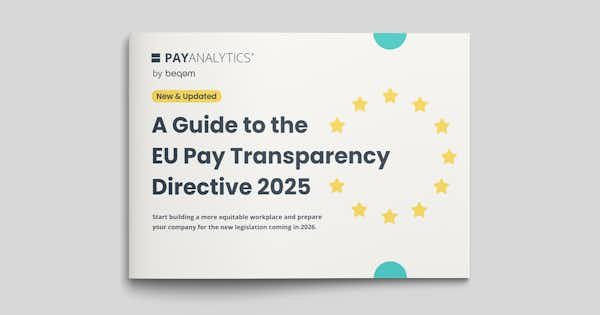A Guide to the EU Pay Transparency Directive 2025 | Download our eGuide for free
Best Practices for Pay Equity External Communications and Gender Pay Gap Disclosure | Part 1
As a critical social issue, pay equity falls under the “S” in corporate social responsibility (CSR) and environmental, social and governance (ESG). So how can you best address pay equity in CSR/ESG reports and other external communications? This two-part blog talks about some best practices and provides plenty of examples.

Pocket guide: Pay equity communication best practices
In the course of helping our clients ensure fair pay, we’ve fielded a lot of questions about how to talk about pay equity – and social responsibility more broadly – in external communications.
These questions naturally arise because of the growing importance of two key concepts: corporate social responsibility (CSR) and environmental, social, and governance (ESG). Pay equity is a social concern, so it falls under the “S” in both of these acronyms.
Social issues are often part of required corporate reporting. But even where it’s not required, many companies have found it advantageous to make social responsibility a fixed part of their communications strategy. For example, one survey found that 85% of investors weigh ESG factors when making investment decisions, and another survey found that almost half of investors consider the “S” in ESG the most important component.
In addition, any communication your organization puts out should be closely tied to your company’s branding. This means that good pay equity communication should convey your values. This is important, since consumers are increasingly looking to buy from and invest in organizations whose values align with their own. Such an alignment of values might translate into an improvement in financial performance, draw in investors, lenders, and potential collaborators, and attract talent.
Yet talking publicly about your organization’s pay equity journey can be challenging. Our aim with this two-part series is to provide you with a clear picture of what makes pay equity communications successful. In Part 1 we’ll introduce some best practices for CSR reports and other documents, and in Part 2, we’ll look at some real-world examples.
- CSR reporting
- ESG reporting
- Press releases
- Webpages
- Pay equity reporting (data-centered; official reports that may be required by national or local governments)
- Pay equity statements (can be written for stakeholders, employees, and/or the public)
When do you start reporting externally on pay equity?
The logistics of external reporting are always unique to each organization. They depend heavily on the organization’s history with ESG goal-setting and reporting as well as what might be required in your country and region. That being said, here are some general guidelines:
Make sure you’ve laid the groundwork internally. If your organization is just starting to think about ESG or is approaching it with a new focus, communicate that to your employees and stakeholders first. You might think of it this way: your organization is starting on a new journey, and they’ll want to know where you’re going and why from the beginning.
Likewise, once you have meaningful data, report it internally first before you share it with a wider audience.
Plan ahead for any legally required external reporting. Make sure you give yourself plenty of time to gather and analyze the data and check the results.
Best practices for ESG and gender pay gap reporting
1️⃣ Make pay equity (and other ESG factors) part of your organization’s goals.
It’s difficult to say much about pay equity or ESG if these concepts seem foreign and external to the people within your company. But if ESG is “baked in” as part of the company’s organizational goals, the actions taken in service of these goals are likely to be meaningful and effective. Then you’ll be able to talk about the progress the company has been making.
2️⃣ Use good data.
Good ESG communication starts with good data. This means:
- Have a strong plan for measuring and analyzing your pay gap.
- You need to know what your data is telling you, so invest in good analysis. This includes quality analytical tools and in training on those tools if necessary. If in-house employees are working on the analysis, make sure they have the time and support they need to do the work.
- Be consistent across all your communications – both in terms of your data and measurements and your values and goals. For example, the goals and values discussed in a press release from the CEO should line up with those in the ESG documents. The pay gap information used in those documents should also be measured in the same way. For example, it would be confusing to have the press release talk about differences in employees’ hourly pay and the ESG documents talk about differences in annual pay.
While the specific data you want to use will always depend on the context, some pay metrics are fairly common in corporate social responsibility reports and other external ESG communications. They are:
- Unadjusted pay gap
- Adjusted pay gap
- Progress metrics (like percentage decrease in pay gap)
- Pay data, broken down by gender (or other demographics of interest)
3️⃣ Be honest.
This goes all the way back to setting your ESG goals: you want to be honest about what your company values and what you hope to do. And you can be open about the policies that you’ve created in service of those goals – don’t be afraid to summarize them or quote directly. In fact, if readers see that you have concrete policies in place, it will help them understand that you’re not just paying lip service to the concept of pay equity, but in fact “practicing what you preach”.
You’ll also want to be honest when reporting your data. However, there are some situations that need to be handled with delicacy. One such situation is when an organization’s analysis reveals a substantial adjusted pay gap. In other words, even after accounting for all the factors that determine pay, there’s still an unexplained difference based on some demographic factor, like gender. (If you’d like more clarification on the difference between adjusted and unadjusted pay gaps, check out this article.)
Options at this point might include reporting the adjusted pay gap at the organization-wide level. If your organization is somewhat large, this information is usually not granular enough to identify specific teams or employees as the source of the gap. Or it may be best to hold off on communicating specific details about the adjusted pay gap until it has been narrowed or closed. If this is the case, though, then you can generally still communicate about the progress your organization is making in closing the gap.
4️⃣ Focus on action and impact.
Your readers will want to know the real-world effect of your ESG work. Your pay equity communications, then, should focus on what the organization is actually doing to make a difference. What actions have been taken, or are being taken? What actions are you planning for the future? Has the organization ended practices that can lead to inequity (like asking for salary history during the hiring process) or implemented new practices? What have these actions accomplished or what are they expected to accomplish? Your readers will want to understand impact in concrete terms, so whenever possible, look for information that is quantifiable. Good measurement tools will help you here.
5️⃣ Think about your framing and storytelling.
The concept of ESG emerged about twenty years ago in response to global concerns about environmental degradation, social injustice, and global and local inequity. People are now very cognizant that no person or organization is an isolated actor – our actions have far-reaching ripple effects. So in your communications, frame your organization as part of the larger human community, sharing a common set of concerns. Your ESG goals and actions are your organization’s way of addressing those concerns.
Once you’ve framed your organization in this bigger context, consider its story in regards to those ESG goals. Often, an organization’s story goes something like this:
- Here’s what motivated us to take more focused action on pay equity.
- Here is what we’ve done so far in response.
- Here is what has happened so far.
- Here is what we expect going forward, including the areas where we plan to take additional action.
However, you can also tell a story that is more focused and specific. This could involve zooming in on one especially exciting action related to pay equity. Or you can focus on the actions or experience of one team or even one person. In Part 2, we’ll see some examples of good ESG storytelling.
6️⃣ Know what information is required for each communication type.
With some document types, like web pages or press releases, you can choose your own adventure in terms of the pay equity information you provide. At the other end of the spectrum, if your company is subject to any national or local pay equity reporting requirements, regulatory authorities provide guidance on what must be included. (To find out more about reporting requirements in your area, see our local requirements page.)
For pay equity statements—separate from ESG reports—although this document type is quite flexible, there are some common norms. The point of a pay equity statement is to show that the organization recognizes the importance of pay equity and is proactively doing something about it. At a minimum, the statement should summarize the organization’s pay equity policy and express a commitment to paying employees fairly. We’ll go into more depth on pay equity statements in Part 2.
7️⃣ Make your communications accessible and easy to understand.
Many good CSR reports, ESG reports, gender pay gap press releases, and pay equity statements use well-designed data visualizations and graphics. This helps readers see the organization’s challenges and progress at a glance. Successful communications also use straightforward language and define terms or clarify concepts as needed. Part 2 will provide some excellent examples.
8️⃣ Consider third-party equal pay certification.
A third-party certification (or “stamp” or “seal”) is an objective evaluation of an organization’s pay equity performance. These certifications are administered by a few organizations, including but not limited to:
- Fair Pay Innovation Lab (FPI), which issues its Universal Fair Pay Check.
- The EDGE Certification Foundation, which has a diversity, equity, and inclusion (DEI) focus.
The certification process starts with a rigorous pay equity analysis. Organizations then develop and follow an action plan, which usually involves closing their adjusted pay gap, implementing policies so the gap doesn’t reopen, and possibly taking some related steps towards broader workplace equity.
For companies who are ready to put in the effort, certification provides a helpful framework for ironing out existing pay equity and workplace equity issues. Another advantage is that certification publicly demonstrates a commitment to pay equity. This can be a big boost to a company’s credibility and reputation and can help attract talent. But there’s one other interesting benefit: it helps build trust among existing employees. Sometimes, even when organizations do take action on pay equity, their employees aren’t quite sure if they actually mean it. In these cases, third-party certification can signal to employees that their employer is in earnest.
This brings us to the end of Part 1 of this article. In Part 2, we’ll talk about some specific subjects that you may need to address in your pay equity external communications. We’ll also look at some shining examples.
In the meantime, we welcome you to book a conversation with one of our pay equity specialists or contact us by e-mail. We’re always happy to talk about your pay equity journey and help you set and meet your goals.
We also have a constantly growing resource library with some articles you might find helpful. Here are a few you may want to check out:
📖 Pay Equity: The Ultimate Guide
📖 Your First Pay Equity Analysis: What Data Do You Need?
The information on this page is not intended to serve and does not serve as legal advice. All of the content, information, and material in this article are only for general informational use. Readers are advised that this information, legal or otherwise, may not be up-to-date.





